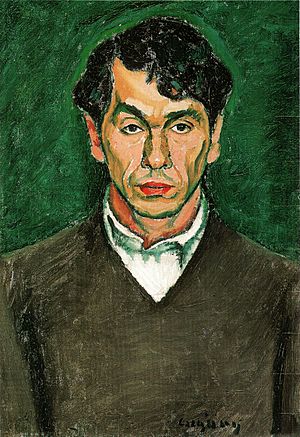Dezső Czigány facts for kids
Quick facts for kids
Dezső Czigány
|
|
|---|---|

Self-Portrait (1912)
|
|
| Born | 1 June 1883 |
| Died | 31 December 1937 |
Dezső Czigány (born June 1, 1883 – died December 31, 1937) was a Hungarian painter. He was born and died in Budapest. He was a member of a famous art group called The Eight. This group showed their art for the first time in Budapest in 1911. They helped bring new art styles like cubism, fauvism, and expressionism to Hungary.
Many artists from The Eight studied in Munich and Paris. They learned new painting techniques there. These artists were part of a lively group of thinkers in Budapest in the early 1900s. They worked with famous poets like Endre Ady and composers like Béla Bartók.
Early Life and Art School
Dezső Czigány was born in Budapest in 1883. His family was Jewish-Hungarian. When he was young, he went to study art in Munich. He also studied in Paris, a big art city. In 1901 and 1903, he studied at the Nagybánya artists' colony in Hungary. This place is now called Baia Mare in Romania.
His Art Career
Czigány wanted to explore new art styles. He joined a group of artists in Budapest called The Eight. Their first art show was in 1909 and was called New Pictures. In 1911, they had another show named The Eight.
Other artists in this group included Károly Kernstok, Béla Czóbel, Róbert Berény, Ödön Márffy, Dezső Orbán, Lajos Tihanyi, and Bertalan Pór. Sculptors Márk Vedres and Vilmos Fémes Beck also worked with them.
The Eight only had three group shows. But they were very important in the art world of Budapest. They joined in events with writers and musicians. Their influence lasted until 1918. The poet Endre Ady was friends with The Eight. Czigány painted a portrait of Ady, as did several other artists in the group. The famous composer Béla Bartók also knew these artists.
By 1914, Czigány and three other members of The Eight were chosen for an art show. This show was at the Vienna Künstlerhaus. The works of Berény and Tihanyi were not accepted. Their art was seen as too new and different.
Czigány painted many still lifes. These are paintings of objects like fruit or flowers. His still lifes often showed a quiet and calm feeling.
Unlike some artists from The Eight, Czigány stayed in Hungary. He lived there for most of his life. Later in his life, he painted many pictures of himself. In these self-portraits, he always looked very serious.
After World War II, there was a special art show in Budapest. It showed only Czigány's paintings. This honored his art. In recent years, people have become more interested in these artists. They helped bring modern art to Hungary. There have been several new art shows about them. For example, in 2004, there was a show about Fauvist art in Hungary. In 2011 and 2012, two big shows celebrated 100 years since The Eight's first exhibit. These shows were in Hungary and Austria.
Exhibits and Legacy
Dezső Czigány's art has been shown in many places.
- 1991–1992, Standing in the Storm: The Hungarian Avant-Garde from 1908–1930, Santa Barbara Museum of Art, Santa Barbara, California.
- 2006, Hungarian Fauves from Paris to Nagybánya, 1904–1914, Hungarian National Gallery.
His work continues to be important today.
- 2010–2011, A Nyolcak (The Eight): A Centenary Exhibition, Janus Pannonius Museum, Pécs.
- 2012, The Eight: Hungary's Highway in the Modern, Bank Austria Kunstforum, Vienna.
See also
- Károly Kernstok
- Róbert Berény
- Béla Czóbel
- Ödön Márffy
- Dezső Orbán
- Bertalan Pór
- Lajos Tihanyi

